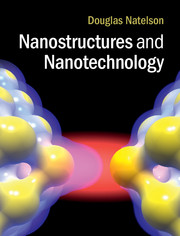Book contents
- Frontmatter
- Contents
- Preface
- Part I
- 1 Introduction and overview
- 2 Solid state physics in a nutshell
- 3 Bulk materials
- 4 Fabrication and characterization at the nanoscale
- 5 Real solids: defects, interactions, confinement
- Part II
- Appendix Common quantum mechanics and statistical mechanics results
- References
- Index
1 - Introduction and overview
from Part I
Published online by Cambridge University Press: 05 July 2015
- Frontmatter
- Contents
- Preface
- Part I
- 1 Introduction and overview
- 2 Solid state physics in a nutshell
- 3 Bulk materials
- 4 Fabrication and characterization at the nanoscale
- 5 Real solids: defects, interactions, confinement
- Part II
- Appendix Common quantum mechanics and statistical mechanics results
- References
- Index
Summary
Nanotechnology has seized both the public and scientific communities' imaginations, and it's not hard to see why. From K. Eric Drexler's and Ray Kurzweil's visions of self-reproducing engineered nanomachines building macroscale structures out of single crystal diamond and swimming through our capillaries repairing damaged cells, to talk of building an elevator directly to geosynchronous orbit, the promise of nanoscale science and engineering has been described to an enthusiastic public. Billions of dollars of research funding have been directed into this area, and further billions of dollars are already being spent on commercial products that are self-described as examples of nanotechnology. Estimates of the global economic impact of nanotechnology in the next ten years exceed $1 trillion, and are rising.
How seriously should we take these exciting visions? Is nanotechnology a “disruptive technology”, a distinct advance that will reshape the world? What are the real potential impacts of the ability to engineer the structure and composition of materials on the nanometer scale? What are the limitations imposed by Nature (that is, physics and chemistry) on what is possible? What physical principles become relevant at small scales that on the one hand set limitations, but on the other provide new opportunities? What scientific questions remain to be answered at the nanometer scale, and why? How can people manipulate and characterize materials on these scales?
Hopefully this book will help you answer these questions, or at least give you a good idea of what to consider when trying. Even though the nanometer scale is very different from our everyday experience, it is possible to develop an intuition about how matter will behave at that extremely small level.
What is nanotechnology?
Nanotechnology is an extraordinarily broad term. According to the US government, nanotechnology is “Research and technology development at the atomic, molecular or macromolecular levels, in the length scale of approximately 1 – 100 nanometer range, to provide a fundamental understanding of phenomena and materials at the nanoscale and to create and use structures, devices and systems that have novel properties and functions because of their small and/or intermediate size.”
- Type
- Chapter
- Information
- Nanostructures and Nanotechnology , pp. 3 - 14Publisher: Cambridge University PressPrint publication year: 2015

